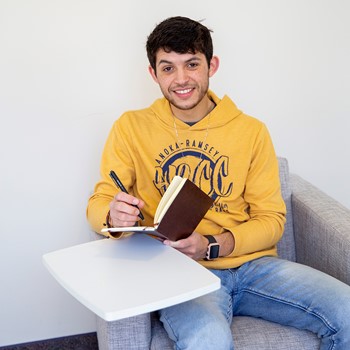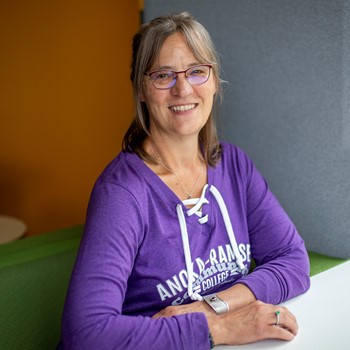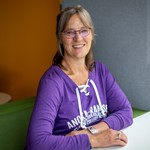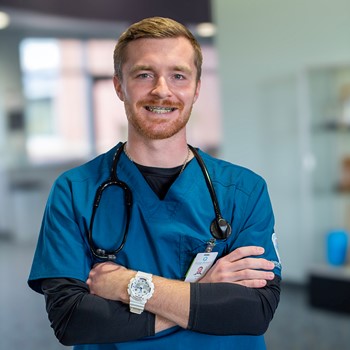Profile - Dr. Patricia (Patty) Pieper
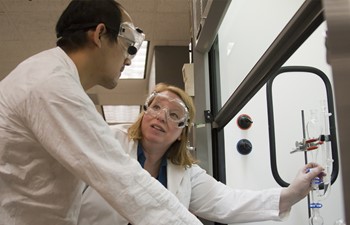
Instructor Profile
Doctor of Philosophy (PhD) in Organic Chemistry, University of Minnesota; Bachelor of Science (BS) in Chemistry, Augsburg College; Bachelor of Arts (BA) in Spanish, Augsburg College
Question and Answer
-
Question
Would you list some recent accomplishments?
Answer
Honors and Awards:
- Anoka-Ramsey Community College’s Academic All-Star Award (2015)
- Two-time finalist for Anoka-Ramsey Community College’s Phi Theta Kappa (PTK) sponsored Golden Chalk Award
- Three-time finalist for Minnesota State Colleges Faculty (MSCF) Most Honored Faculty Award
- Anoka-Ramsey Community College PTK sponsored Silver Chalk Award Winner (2002-2003 academic year)
- National Institutes of Health Predoctoral Trainee, The Chemical Basis of Cell and Molecular Biology Training Grant (October 1991 – June 1994)
- University of Minnesota Chemistry Department Fellowship (September 1990 – June 1991)
- National Institute of Chemists Student Award (1989)
- Augsburg College Conrad Sunde Chemistry Scholarship (1989)
- Augsburg College Organic Chemistry Kekule Prize (1988)
- Augsburg College 3M Chemistry Scholarship (1988)
Publications:
- Pieper, Patricia; Lutz, Christopher; Grant, Jennifer; Aspaas, Andrew; MALDI Education: MALDI-TOF Implementation Materials, MALDI Activities 1 – 4, anokaramsey.edu/MALDIEducation/maldi-tof-implementation-materials/, 2016.
- “Multiple-Choice Testing in Organic Chemistry: Can Feedback Make a Difference?”, S. Hein, J. Schneider, Chem. Ed., (in preparation)
- “3-Deoxy-3-fluoropyridoxamine-5’-phosphate: The Synthesis, Chemical and Biological Properties of a Coenzyme B6 Analogue”, P.A. Pieper, D-y. Yang, H-q. Zhou & H-w. Liu, Am. Chem. Soc., 1997, 119, 1809-1817.
- “Studies of the Redox Properties of CDP-6-deoxy-L-threo-D-glycero-4-hexulose-3-dehydrase (E1) and CDP-6-deoxy-L-threo-D-glycero-4-hexulose-3-dehydrase reductase (E3): Two Important Enzymes Involved in the Biosynthesis of Ascarylose”, K.A. Burns, P.A. Pieper, H-w. Liu & M.T. Stankovich, Biochemistry, 1996, 35, 7879-7889.
- “Mechanistic Studies of the Biosynthesis of 3,6-Diodeoxy Sugars: Stereochemical Analysis of C-3 Deoxygenation”, P.A. Pieper, Z. Guo & H-w. Liu, Amer. Chem. Soc. 1995, 117, 5158-5159.
-
Question
What is your approach to teaching?
Answer
In all the courses I teach at Anoka-Ramsey, I strive to form personal connections with my students and to provide a flexible, fair, and active learning environment. In order to promote deeper learning, I use a method called Process-Oriented Guided Inquiry Learning (POGIL), a teaching technique where students work in groups on guided inquiry materials designed to simultaneously teach content, have students think analytically, and work effectively as part of a team. I also use more traditional teaching methods where I embed problems in the lecture notes that students solve themselves after I have demonstrated how to solve similar types of problems. I strive to provide fair assessments and to give many opportunities for student mastery of course content, while also being flexible when unforeseen things happen that interfere with course requirements. Getting to know students on a personal level is the part of my job that I enjoy the most. My hope is that the relationships that we build together allow students to feel comfortable approaching me with questions so they can get the most out of the course.
-
Question
What inspires you as a teacher?
Answer
My favorite aspect of teaching is helping students in their learning process and watching them grow in their abilities and understanding of the “central science” of chemistry. I am especially inspired when a student who thought they wouldn’t like chemistry, perhaps due to a bad experience in a previous course, finds that it is more interesting and enjoyable than expected.
-
Question
How would you describe what happens during one of your most successful classes?
Answer
In my most successful classes, all students are completely engaged and focused on the topic of the day. If I am using a group-work method, like POGIL, I get satisfaction seeing students actively discussing the material with their group and completely engrossed in the chemistry content.
-
Question
What makes your curriculum interesting or valuable to students?
Answer
Chemistry is unique among the sciences in that there is a connection to chemistry in almost every aspect of the physical world. Students learn what things are made of and that chemical principles can be used to determine almost all reasons for any property of matter. Our knowledge of fundamental chemistry has allowed innovations that have improved the quality of life for countless people throughout the world. The development of the many forms of plastics – so abundant in our everyday lives – was made possible by an understanding of chemistry. Chemistry helps us comprehend the mechanisms for life, and it can save lives in the form of specialized organic compounds known as medicinal drugs. Chemistry is oftentimes referred to as the “Central Science” as many other areas of science, whether it be engineering, biology, or geology, utilize chemical knowledge in their fields. A basic understanding of chemistry is important for every student, as we all live in a physical world that functions based upon chemical principles.
-
Question
How do you think students describe your teaching methods and classes?
Answer
I think many students feel that I am an enthusiastic teacher who cares about students’ progress and performance in the courses they take with me. I believe most students feel that I try to present the course material in ways that make it more engaging, such as promoting students to work on problems during class by themselves or in small groups, or by doing chemical demonstrations, which are a memorable and entertaining way to help illustrate important concepts in the course. In addition, I think most students feel that I give fair assessments of the course material and that I try to be open and available for questions both in and out of class.
-
Question
What are some ways that you help students succeed when they need extra help?
Answer
First, and foremost, I emphasize my openness and availability for questions, both during and outside of my office hours. I have an open door policy for students to come and talk with me. If I notice a particular student struggling with the course material, I sometimes approach that student to see if he/she would like to make an appointment to discuss the content areas that are causing problems. Sometimes the struggling student approaches me. In either case, I do my best to find a time that works for both of us so that we can begin to address the issues together.
During a meeting with a student, I usually support the student in overcoming their confusion by checking on his/her work on specific problems or by walking through a step-by-step process for how to solve a problem. In addition, near the beginning of each semester, I typically have a chemistry tutor from ARCC’s Academic Support Center visit my courses and announce the availability of peer tutoring services for chemistry, as my availability doesn’t always work with student schedules. Overall, I find many students are comfortable asking me for help and that I commonly meet with students to address their chemistry questions.
-
Question
How do you help your students get the most out of your class?
Answer
I structure my courses to promote student mastery of the chemistry content. I promote this mastery by how I cover the course content, by what I expect students to do themselves in class and in lab, and by what I assign for learning activities outside of class as well. These outside-of-class learning activities include the online and end-of-chapter homework, the lab reports and worksheets or post-lab quizzes, and the reading assignments. In class, if I am using a lecture format, I work through as many example problems as time allows and also have students work on problems themselves. If I am using a group work learning format, I make an effort to assess whether students are learning the material by asking class questions at appropriate times and checking student group work answers as well. As I mentioned above, I try to be open and available for questions and to promote the peer tutoring available at the Academic Support Center. Finally, I design and administer quizzes and exams that assess the main chemistry concepts that I have covered in class and assigned in the reading, the laboratory, and in the homework.
Fun Facts
-
Fun Fact #1
During my graduate school years, I did research in the field of bio-organic chemistry, more specifically studying mechanistic enzymology.
-
Fun Fact #2
During my undergraduate years, I studied abroad for two semesters - one in Mexico and one in Spain.
-
Fun Fact #3
I have been married since 1992 to Rich and have two grown daughters in their twenties and three grown stepchildren in their thirties.

